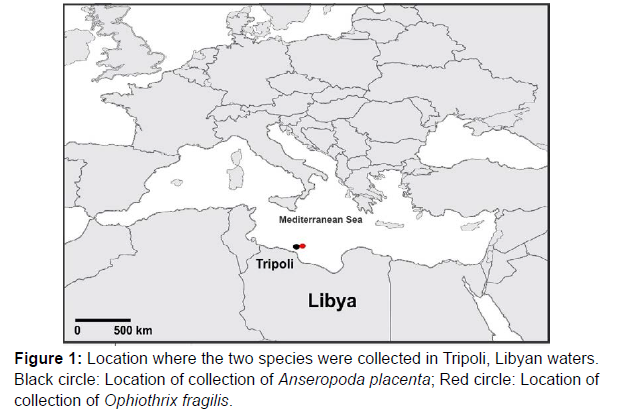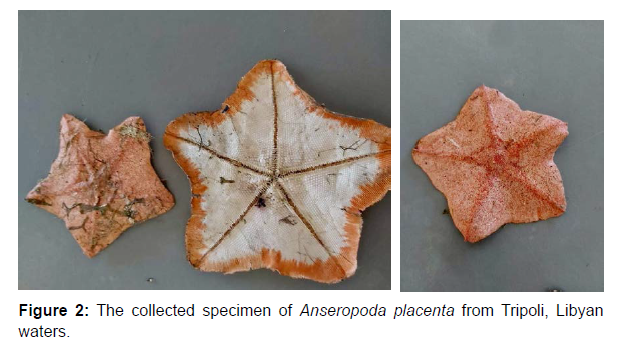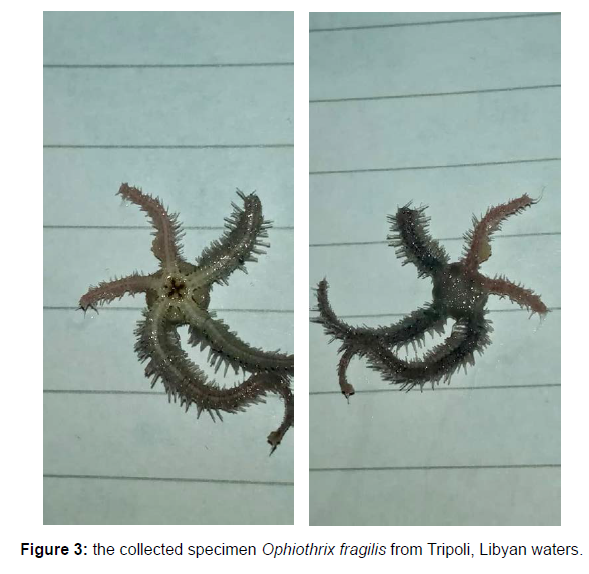First Record of Two Species of Echinodermata for Libyan Waters
Received: 24-Dec-2021 / Manuscript No. jflp-21-50547 / Editor assigned: 27-Dec-2021 / PreQC No. jflp-21-50547 (PQ) / Reviewed: 10-Jan-2022 / QC No. jflp-21-50547 / Revised: 17-Jan-2022 / Manuscript No. jflp-21-50547 (R) / Accepted Date: 17-Jan-2022 / Published Date: 24-Jan-2022 DOI: 10.4172/ 2332-2608.1000325
Abstract
Two species of Echinodermata were reported for the first time from the deep Libyan waters. The goose foot starfish Anseropoda placenta (Pennant, 1977) and the common brittle star Ophiothrix fragilis (Abildgaard in O.F. Müller, 1789) were observed in Tripoli, Libyan waters by Libyan fishers. Subsequently, they are collected by trawling in the deep waters. This report discusses details of these new observations.
Keywords: Anseropoda placenta; Ophiothrix fragilis; Libyan waters
Keywords
Anseropoda placenta; Ophiothrix fragilis; Libyan waters
Introduction
The benthic macro fauna, especially belonging to the phylum Echinodermata, is insufficiently studied in the Libyan waters. Accordingly, there is a gap in knowledge and insufficient data related to this topic. This is due to the lack of comprehensive studies and research dealing with this kind of marine branch. Nevertheless, it is already confirmed the presence of common Echinodermata species in the Libyan waters [1-4]: Arbacia lixula (Linnaeus, 1758), Asterina pancerii (Gasco, 1876), Coscinasterias tenuispina (Lamarck, 1816), Centrostephanus longispinus (Philippi, 1845), the Non-Indigenous Species (NIS) Diadema setosum (Leske, 1778), Echinaster (Echinaster) sepositus (Retzius, 1783), Holothuria (Platyperona) sanctori Delle Chiaje, 1823, Holothuria (Holothuria) tubulosa Gmelin, 1791, Ophidiaster ophidianus, NIS Ophiocoma scolopendrina (Lamarck, 1816), Paracentrotus lividus (Lamarck, 1816). However, Echinodermata species from the Libyan waters remain insufficiently studied. This note reports two species of Echinodermata recorded for the first time from the deep Libyan waters.
In August 2020, one individual of both species Anseropoda placenta and Ophiothrix fragilis were collected by trawling at 73 m, and 78 m depth, respectively, in Tripoli, Libyan waters (Figure 1). Accordingly, the collected specimens were shared with one of us (AF) for identification. The two specimens were preserved in alcohol.
The goose foot starfish Anseropoda placenta (Pennant, 1977) is belonging to the order Valvatida and family Anseropodidae. It is an Atlanto-Mediterranean species [5]. The species occurs sub tidally from 10-500 m depth on muddy sand or muddy gravel. A. placenta is collected at 73 m depth of a muddy sand bottom of the Libyan waters. A placenta is characterized by its very thin body taking a leaf like form with around 200 mm diameter. It is distinguished by five short webbed arms and its skin with granular textures of small plates. In addition, A. placenta has on its upper surface a red disc and five red lines radiating along the arms with pale pink between them (Figure 2). It feeds on benthic crustaceans (amphipods, cumaceans, mysids, crabs and hermit crabs), molluscs and echinoderms [6].
The common brittle star Ophiothrix fragilis (Abildgaard in O.F. Müller, 1789) is belonging to the order Amphilepidida and family Ophiotrichidae. It is a common species of the Northeast Atlantic Ocean, Black, and Mediterranean Seas [5 and 7]. This species prefers hard substrata including sand and shell bottoms and is often found in empty shells or under stones, from shallow water down to 350 m. It has also been reported from the eastern Mediterranean caves [8]. O. fragilis was collected at 78 m depth in a sand bottom of the Libyan waters. It is characterized by its grey ranging through red body color with around 20 mm in diameter. It is distinguished by its five long, slim, and spiny arms, typically five times the diameter of the body in length (Figure 3) [6 and 9]. Common brittle stars are detritivorous species feeding on decaying material from the ocean floor. They feed on diatoms, and phytoplankton, and they are prey to many species of fish, crabs, and some species of starfish [9].
From an ecological point of view, the presence of Anseropoda placenta, Ophiothrix fragilis in Libyan waters provide several ecosystems functions and services. They play an essential ecological role as high-level predators in the structure and function of intertidal and sub tidal benthic communities, where they promote heterogeneity and diversity [9 and 10]. In addition, some Ophiurids, like Ophiothrix fragilis can have large aggregations that provide similar ecological roles to mollusks reefs: they enhance organic matter deposition, increase benthic-pelagic coupling and foster the presence of species among them [11].
These two new marine records from the Libyan waters prove the efficacy of citizen-sciences as an important monitoring tool for reporting new marine species. Accordingly, these new records of Echinodermata species in the Libyan waters complement the data known from this region.
In this context, it is recommended to enhance citizen science as an effective monitoring tool to detect new marine species in the Libyan waters. Furthermore, within citizen science, and for better results, it is necessary to focus on enhancing the link between Libyan fishers and research.
From a protection and conservation point of view, further research on Echinodermata diversity in the Libyan waters is required to monitor the existing species status and investigate the presence of new records, especially the non-indigenous ones. Finally, it is also essential to finalize an updated checklist of the Echinoderms species from the Libyan waters.
Acknowledgements
The authors wish to thanks the fisher and diver Mohamad Barka for collecting the specimens and sharing them with us.
References
- Par Pergent G, Bazairi H, Langar H, Sghaier YR (2010) Caractérisation des principales biocénoses présentes le long du littoral du Parc National d’El Kouf (Libye). CAR/ASP - PNUE/PAM.
- Shakman E (2017) National monitoring programme for Biodiversity in Libya. Regional Activity Centre for Specially Protected Areas, p: 60.
- Badalamenti F, Ben Amer I, Dupuy De La Grandrive R, Foulquie M, et al. (2011) Scientific field survey report for the development of Marine Protected Areas in Libya. Google Scholar: 32.
- Shakman E, Eteayb K, Taboni I, Abdalha AB (2019) Status of marine alien species along the Libyan coast. J Black Sea/Medit Env: 25.
- Koukouras A, Sinis AI, Bobori D, Kazantzidis S, Kitsos MS (2007) The echinoderm (Deuterostomia) fauna of the Aegean Sea, and comparison with those of the neighbouring seas. J Biol Res 7: 67-92.
- Picton BE, Morrow CC (2007) Anseropoda placenta. Encyclopedia of Marine Life of Britain and Ireland.
- Stöhr SABINE, Cinar ME, Dagli E (2010) Brittle stars (Echinodermata: Ophiuroidea) from the southern coast of Turkey (eastern Mediterranean): new records and revision of Amphiodia obtecta Mortensen, 1940. Zootaxa 2483: 45-57.
- Gerovasileiou V, Chintiroglou C, Vafidis D, Koutsoubas D, Sini M (2015) Census of biodiversity in marine caves of the eastern Mediterranean Sea. Mediterr Mar Sci 16: 245-265.
- Holland P (2012) Ophiothrix fragilis (On-line), Animal Diversity Web.
- Jangoux M, Lawrence J M (1982) Echinoderm nutrition. CRC Press.
- Geraldi NR, Bertolini C, Emmerson MC, Roberts D, Sigwart JD (2017) Aggregations of brittle stars can perform similar ecological roles as mussel reefs. Mar Ecol Prog Ser 563: 157-167.
Citation: Fitori A, Fituri AE, Aguilar R, Badreddine A (2022) First Record of Two Species of Echinodermata for Libyan Waters. J Fisheries Livest Prod 10: 325. DOI: 10.4172/ 2332-2608.1000325
Copyright: © 2022 Fitori A, et al. This is an open-access article distributed under the terms of the Creative Commons Attribution License, which permits unrestricted use, distribution, and reproduction in any medium, provided the original author and source are credited.
Select your language of interest to view the total content in your interested language
Share This Article
Recommended Journals
Open Access Journals
Article Tools
Article Usage
- Total views: 4373
- [From(publication date): 0-2022 - Dec 09, 2025]
- Breakdown by view type
- HTML page views: 3584
- PDF downloads: 789



